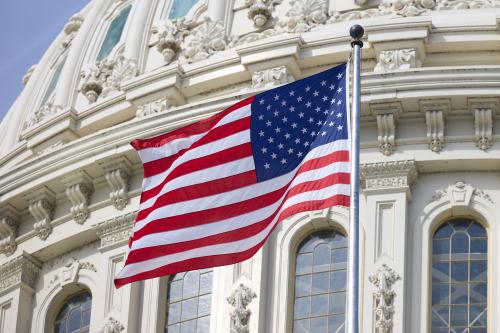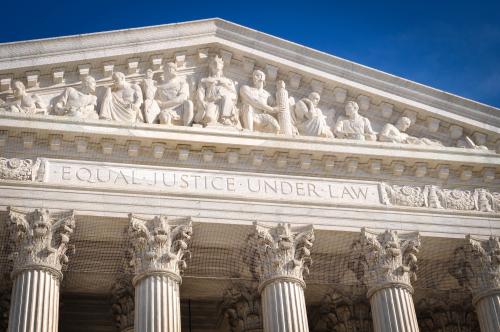Henry Aaron attended all three days of the Supreme Court’s hearings on the Patient Protection and Affordable Care Act and provided daily commentary on the Brookings Up Front blog. Aaron summarized the events of each day while providing insight into each sides’ oral arguments.
Read Aaron’s accounts of the first day and the third and final day.
After two days of oral arguments, it seems quite likely that the Supreme Court will rule on the ACA, and that the mandate may not survive. The court seems unlikely to dodge the issue by saying that the penalty for failure to carry insurance is a tax about which no one can sue until they have paid it, some time in 2015. And the line is rather clearly drawn between two major issues that will, I think, prove pivotal in how the justices rule on the mandate to carry insurance.
If yesterday’s audience was lightly salted with administrative and legislative luminaries, today’s audience was heavily seasoned with officials from the administration, including Gene Sperling, Valerie Jarrett, and Nancy DeParle, and a veritable who’s who of members of Congress, including Mitch McConnell, Max Baucus, Chuck Grassley, Patrick Leahy, Tom Harkin, and numerous members from the House.
The initial presentation was by Don Verilli, the solicitor general, who quickly came under assault from Justices Scalia, Alito, Roberts, and to a lesser extent, Kennedy through a series of questions whose common element was “if you can compel people to buy insurance, what can’t you compel them to do?” The response, repeated from written briefs, was twofold. First, virtually everyone uses health care time or another during their lives and most use insurance at one time or another. Second, the absence of (near) universal coverage generates costs that are imposed on those who do buy insurance; and, since Congress clearly has the authority to regulate insurance, the act of not buying insurance affects something Congress can regulate and hence is, in turn, subject to regulation.
Several of the justices, notably Scalia and Alito, responded to the externalities argument by saying that every economic transaction creates similar externalities. “If I don’t buy a Volt, I raise the price of Volts,” said Scalia. Alito said much the same thing. So did Paul Clement’s brief for the plaintiffs.
This response was and is bad economics. It is true that every commodity is produced along what economists call a “cost curve”—raising output may lower average or marginal unit costs by spreading overhead or achieving economies of scale, but it may also raise costs by forcing up the cost of inputs or incurring diseconomies of scale. None of this occasions concerns about fairness or free-loading or, to use the economist’s term, “externalities.” But the cost shifting that occurs when uninsured patients fail to pay their bills does; it causes one group—the insured—to have to pay part of the cost of services others use.
Perhaps the most glaring instance of the failure to appreciate what an externality really is came from Justice Alito who at one point challenged the solicitor general by positing that the cost of all of the care currently used by those who are uninsured is less than would be the cost of the insurance they would be forced to carry. That being the case, Alito asked, how can one say that the uninsured are shifting costs to the insured? This query is painfully detached from an understanding of what an externality really is, how insurance works, or what the impact of insurance would be on service use.
The justices challenging the externalities view also demanded to know what limits on congressional authority could exist if Congress was empowered in this case to require the purchase of insurance. The word “broccoli” came up a few times! The solicitor general tried to answer this question, but, in my view, failed. And it seemed quite clear that the conservative justices were not satisfied with his response. Scalia asked for a principled basis for drawing a line that would limit congressional power. Alito asked again for a simple definition of such a limit.
Verilli failed to do so. Having read some lower court decisions and some of the briefs, I believe that the reason why Mr. Verilli failed is that no such definition does or can exist. The simple fact is that virtually everything is or can be construed as interstate commerce and that when the Constitution authorized Congress to regulate it and gave it all reasonable and proper means to do so, it—the Constitution—made it impossible to give a principled limit. The task of creating such a limit arises through particular facts and circumstances and the decisions by the courts on what is “reasonable and proper.” It is the facts and circumstances surrounding the way in which we in the United States pay for health care and the externalities that payment arrangements generate that creates the special conditions that distinguish health care from other commodities that Congress cannot compel people to buy. It is easy to understand why thoughtful people would be uncomfortable with this result, since conservatives and liberals alike are and should be worried that Congress will intrude impermissibly on individual freedoms.
Another intellectual cleavage line between those sympathetic to the mandate and those skeptical about it or simply opposed was implicit. Opponents of the mandate seemed clearly to be thinking about relatively brief time periods—a year, or something like that. People may or may not be “active” in the health insurance or the health care market, over such a period. Hence, there are those who can freely choose to be outside the market as opposed to those who freely choose to be in the market. These are seen as distinct groups, and forcing one of them to do something that they don’t normally do or want to do infringes their freedom. If one is going to do that one should have a damn good reason, as well as some principle on the basis of which one can be sure that Congress won’t be empowered to do a whole lot more that would infringe their freedom.
Advocates of the mandate, on the other hand, see the relevant time period as some very much longer period, perhaps the individual lifetime. Thus, there is no real distinction between the health 20-year-old who chooses to go without insurance and uses no health care and the feeble, disease-ridden 80-year old who quite literally could not live without them. These two people are simply time-lapse images of the same human being. In discrete time, it is the pooling achieved through mandatory insurance that makes the multiple stages of the life-cycle fuse into a single sharply-imaged entity. I believe that the lawyers defending the ACA failed to create a sufficiently vivid story to elicit the life-cycle framing that is, in my view, necessary and sufficient to sustain the mandate. Whether the internal debates among the justices will do so is quite uncertain.



Commentary
The Second Day of the Supreme Court’s Hearing on the Health Care Law
March 27, 2012